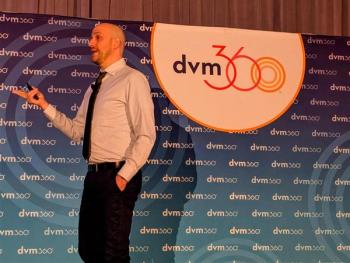
Digital radiography: What is new (Proceedings)
This session will discuss the relative advantages and disadvantages of digital radiography. This modality can save time, money and frustration, but comes with an initial up-front financial cost.
This session will discuss the relative advantages and disadvantages of digital radiography. This modality can save time, money and frustration, but comes with an initial up-front financial cost.
Conventional (analog) radiography
Although there are some advantages to conventional radiography, new digital images carry many advantages. The major disadvantages of conventional radiography are significant and rate limiting. Information stored on a film cannot be adjusted following the exposure. There is a limited range of useful exposures that will produce a diagnostic radiograph. This narrow dynamic range means that we need an exposure chart for each body part commonly radiographed and if mistakes are made, either in the chart or the measurement of the part, then the information will be lost. There is a significant expense (time, space and financial) with chemical processing. Film is bulky and difficult to archive. Distribution of film images is time consuming and expensive.
Digital radiographs
Digital images are formed from a discrete number of picture elements (pixels) arranged in a rectangular matrix. The spatial resolution of the image is determined mainly by the size of the pixels used to make the image. The smaller the pixels the greater the spatial resolution. The contrast resolution is determined by the number of shades of grey (typically 4,000) that can be assigned to each pixel. However, the digital image can be manipulated to use all the pixels, so that assigned pixel values are visible at the same time.
Digital systems convert the pattern of photons reaching the detector into an electrical signal that is digitized. Digital systems are only good and the resolution of the detector and the system of converting the digitized signal to a readable image. There is more of a linear relationship between exposure to displayed signal, therefore we avoid the "shoulder" and "toe" regions on conventional radiographs. Once a radiograph is white or black, then all information is gone and no viewing condition recoups that information. The dynamic range refers to the range of exposures which result in a diagnostic image. The dynamic range of digital radiographs is 4-10 times greater than conventional radiographs.
There are two types of digital radiographs, which differ in the way the x-ray photon pattern is converted to an electrical signal.
Computed radiography
Computed radiography (CR) systems use a cassette that's look similar to a conventional radiographic cassette. Within the cassette is an imaging plate made from a photostimulable phosphor. When x-rays photons hit the plate there is a transfer of energy to electrons within the plate. To display an image from this energy transfer the cassette is loaded into a image reader. Within the image reader a laser moves backwards and forward releasing the energy in the form of light. The light is detected by a photomultipier tube that converts the light to electrical energy. The intensity of the light is proportional to the number and energy of the x-ray photons originally striking the plate. The plate is then erased by a bright light and the plate loaded back in the cassette.
Direct digital radiography
Direct digital radiographic systems (DR) allow the conversion of x-ray photon energy to visible light and thereafter to electrical charge without handling of the plate. These systems have the very important advantage of time saving. There are three main DR types.
In the most sophisticated systems there is direct conversion of the x-ray photon into an electrical charge using a phosphoconductor detector. When x-ray photons strike the detector electro or liberated from the negatively charged from surface and attracted to the positively charged back of the detector. The electrons are detected by a thin film transistor array to create the final image.
Alternatively is indirect conversion using a scintillator that produces light when hi by x-ray photons. The light is converted to electrical signal using a light-sensitive sensor; charged couple device (CCD). This is indirect because there is the middle step of light production between the x-ray photon and electrical signal.
The third technology involves the indirect conversion where the scintillator is built into a flat panel detector with thousands of tiny photodiodes used to generate the electrical signal.
Final display of the image depends on complex image algorithms for different body areas and systems. This may involve enhancement of edges or reduction of noise to optimize the visual acceptability of the final image.
Overall advantages of digital radiographs include wide dynamic range and exposure of the final images. Images are very easy to distribute quickly depending on the practices preferences. This technology replaces chemicals and film. No more darkroom space is required. Overall space requirements are much less, especially for image storage and processing.
DICOM
Although there are many image file types in conventional photography (jpeg, tiffs,etc.), there is only one acceptable image file format in radiology. The DICOM (Digital Imaging and Communications in Medicine) standards were established by the American College of Radiology in the 80's to standardized image file formats and maintain the medical legal standard of a image that was permanent and labeled with patient data, hospital identification and date of imaging. These are the same standard as conventional radiographs but previously unavailable in digital imaging.
With the enhancements made in DICOM (Version 3.0), the Standard was now ready to deliver on its promise not only of permitting the transfer of medical images in a multi-vendor environment, but also facilitating the development and expansion of picture archiving and communication systems (PACS) and interfacing with medical information systems.
The practical significance of utilizing the DICOM standard are the guarantee of high image quality and universal acceptability of the images by all potential readers. This eliminates a vendor's proprietary file format only readable, by the practice and consultant alike, by vendor software. No system should be considered unless the vendor guarantees DICOM image standards.
PACS
A PACS network is the integration of computers able to view and manipulate images. The PACS (picture archive and communication system) deals with image storage, retrieval, distribution and presentation in a practice, between practices and between practices and their consultants. The PACS may be the most important aspect to a successful installation of DR into a practice.
Summary
Digital radiography has tremendous advantages over conventional radiography. DR allows automatic correction for over or under exposure. There is control of contrast through image processing instead of radiographic technique. No more lost cases! More "fun" for veterinarians and veterinary technicians. More radiographs are taken because of ease of obtaining a high quality image. More diagnostic value in the overall radiographic process and a more profitable practice.
References
lACR/NEMA Standards Publication No. 300-1985 version 2.0 in 1985; current version 3.0 in 1993
Newsletter
From exam room tips to practice management insights, get trusted veterinary news delivered straight to your inbox—subscribe to dvm360.




